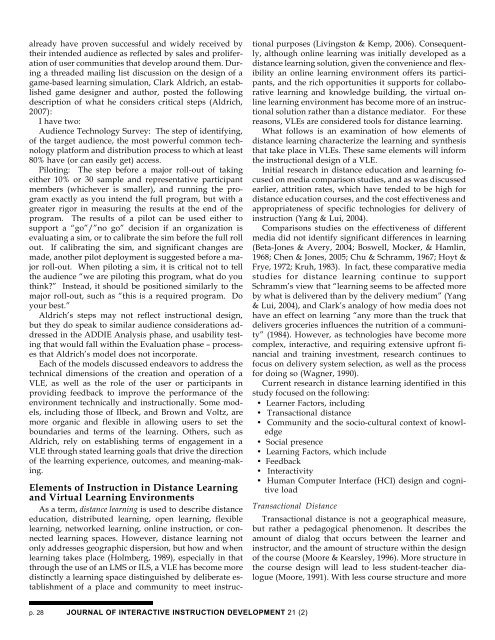Instructional Design Factors as they Relate to the ... - Anitacrawley.net
Instructional Design Factors as they Relate to the ... - Anitacrawley.net
Instructional Design Factors as they Relate to the ... - Anitacrawley.net
Create successful ePaper yourself
Turn your PDF publications into a flip-book with our unique Google optimized e-Paper software.
already have proven successful and widely received by<strong>the</strong>ir intended audience <strong>as</strong> reflected by sales and proliferationof user communities that develop around <strong>the</strong>m. Duringa threaded mailing list discussion on <strong>the</strong> design of agame-b<strong>as</strong>ed learning simulation, Clark Aldrich, an establishedgame designer and author, posted <strong>the</strong> followingdescription of what he considers critical steps (Aldrich,2007):I have two:Audience Technology Survey: The step of identifying,of <strong>the</strong> target audience, <strong>the</strong> most powerful common technologyplatform and distribution process <strong>to</strong> which at le<strong>as</strong>t80% have (or can e<strong>as</strong>ily get) access.Piloting: The step before a major roll-out of takingei<strong>the</strong>r 10% or 30 sample and representative participantmembers (whichever is smaller), and running <strong>the</strong> programexactly <strong>as</strong> you intend <strong>the</strong> full program, but with agreater rigor in me<strong>as</strong>uring <strong>the</strong> results at <strong>the</strong> end of <strong>the</strong>program. The results of a pilot can be used ei<strong>the</strong>r <strong>to</strong>support a “go”/”no go” decision if an organization isevaluating a sim, or <strong>to</strong> calibrate <strong>the</strong> sim before <strong>the</strong> full rollout. If calibrating <strong>the</strong> sim, and significant changes aremade, ano<strong>the</strong>r pilot deployment is suggested before a majorroll-out. When piloting a sim, it is critical not <strong>to</strong> tell<strong>the</strong> audience “we are piloting this program, what do youthink?” Instead, it should be positioned similarly <strong>to</strong> <strong>the</strong>major roll-out, such <strong>as</strong> “this is a required program. Doyour best.”Aldrich’s steps may not reflect instructional design,but <strong><strong>the</strong>y</strong> do speak <strong>to</strong> similar audience considerations addressedin <strong>the</strong> ADDIE Analysis ph<strong>as</strong>e, and usability testingthat would fall within <strong>the</strong> Evaluation ph<strong>as</strong>e – processesthat Aldrich’s model does not incorporate.Each of <strong>the</strong> models discussed endeavors <strong>to</strong> address <strong>the</strong>technical dimensions of <strong>the</strong> creation and operation of aVLE, <strong>as</strong> well <strong>as</strong> <strong>the</strong> role of <strong>the</strong> user or participants inproviding feedback <strong>to</strong> improve <strong>the</strong> performance of <strong>the</strong>environment technically and instructionally. Some models,including those of Ilbeck, and Brown and Voltz, aremore organic and flexible in allowing users <strong>to</strong> set <strong>the</strong>boundaries and terms of <strong>the</strong> learning. O<strong>the</strong>rs, such <strong>as</strong>Aldrich, rely on establishing terms of engagement in aVLE through stated learning goals that drive <strong>the</strong> directionof <strong>the</strong> learning experience, outcomes, and meaning-making.Elements of Instruction in Distance Learningand Virtual Learning EnvironmentsAs a term, distance learning is used <strong>to</strong> describe distanceeducation, distributed learning, open learning, flexiblelearning, <strong>net</strong>worked learning, online instruction, or connectedlearning spaces. However, distance learning no<strong>to</strong>nly addresses geographic dispersion, but how and whenlearning takes place (Holmberg, 1989), especially in thatthrough <strong>the</strong> use of an LMS or ILS, a VLE h<strong>as</strong> become moredistinctly a learning space distinguished by deliberate establishmen<strong>to</strong>f a place and community <strong>to</strong> meet instructionalpurposes (Livings<strong>to</strong>n & Kemp, 2006). Consequently,although online learning w<strong>as</strong> initially developed <strong>as</strong> adistance learning solution, given <strong>the</strong> convenience and flexibilityan online learning environment offers its participants,and <strong>the</strong> rich opportunities it supports for collaborativelearning and knowledge building, <strong>the</strong> virtual onlinelearning environment h<strong>as</strong> become more of an instructionalsolution ra<strong>the</strong>r than a distance media<strong>to</strong>r. For <strong>the</strong>sere<strong>as</strong>ons, VLEs are considered <strong>to</strong>ols for distance learning.What follows is an examination of how elements ofdistance learning characterize <strong>the</strong> learning and syn<strong>the</strong>sisthat take place in VLEs. These same elements will inform<strong>the</strong> instructional design of a VLE.Initial research in distance education and learning focusedon media comparison studies, and <strong>as</strong> w<strong>as</strong> discussedearlier, attrition rates, which have tended <strong>to</strong> be high fordistance education courses, and <strong>the</strong> cost effectiveness andappropriateness of specific technologies for delivery ofinstruction (Yang & Lui, 2004).Comparisons studies on <strong>the</strong> effectiveness of differentmedia did not identify significant differences in learning(Beta-Jones & Avery, 2004; Boswell, Mocker, & Hamlin,1968; Chen & Jones, 2005; Chu & Schramm, 1967; Hoyt &Frye, 1972; Kruh, 1983). In fact, <strong>the</strong>se comparative medi<strong>as</strong>tudies for distance learning continue <strong>to</strong> supportSchramm’s view that “learning seems <strong>to</strong> be affected moreby what is delivered than by <strong>the</strong> delivery medium” (Yang& Lui, 2004), and Clark’s analogy of how media does nothave an effect on learning “any more than <strong>the</strong> truck thatdelivers groceries influences <strong>the</strong> nutrition of a community”(1984). However, <strong>as</strong> technologies have become morecomplex, interactive, and requiring extensive upfront financialand training investment, research continues <strong>to</strong>focus on delivery system selection, <strong>as</strong> well <strong>as</strong> <strong>the</strong> processfor doing so (Wagner, 1990).Current research in distance learning identified in thisstudy focused on <strong>the</strong> following:• Learner <strong>Fac<strong>to</strong>rs</strong>, including• Transactional distance• Community and <strong>the</strong> socio-cultural context of knowledge• Social presence• Learning <strong>Fac<strong>to</strong>rs</strong>, which include• Feedback• Interactivity• Human Computer Interface (HCI) design and cognitiveloadTransactional DistanceTransactional distance is not a geographical me<strong>as</strong>ure,but ra<strong>the</strong>r a pedagogical phenomenon. It describes <strong>the</strong>amount of dialog that occurs between <strong>the</strong> learner andinstruc<strong>to</strong>r, and <strong>the</strong> amount of structure within <strong>the</strong> designof <strong>the</strong> course (Moore & Kearsley, 1996). More structure in<strong>the</strong> course design will lead <strong>to</strong> less student-teacher dialogue(Moore, 1991). With less course structure and morep. 28 JOURNAL OF INTERACTIVE INSTRUCTION DEVELOPMENT 21 (2)
















